Water Technology Kazincbarcika: Hungary strengthens its production base
Major milestone for the production base in Hungary. The water technology plant in Kazincbarcika has received a new reactor for the first time. Read why this replacement was important, what challenges we faced and how everything went.
Ferric chloride and polyaluminum chloride for wastewater treatment
The products of the water technology plant in Hungary – ferric chloride and polyaluminum chloride – are indispensable for the proper purification of municipal and industrial wastewater for the environment before it is then "released back into nature" from the wastewater treatment plant.
The production of these products, however, places high demands on the industrial production facilities, which have to withstand a lot. It is therefore only natural that the reactors in particular have a limited service life - usually five to eight years. It is therefore quite remarkable that the polyaluminum chloride reactors in Kazincbarcika have already entered their eleventh year thanks to careful handling and good maintenance.

Complex challenges: the first reactor replacement in March
The first reactor replacement took place in March. This rather complex undertaking required meticulous coordination between a wide range of service providers and the company's own teams:
- All supply and discharge lines for raw materials, finished product and energy had to be disconnected.
- The steel hall struts were removed.
- The hall roof was opened over several square meters.
- The old reactor was lifted out with two huge cranes in millimeter work.
- Finally, the new reactor was lifted in and placed exactly on the intended base.
- Then, of course, all the pipes had to be reconnected.
- Finally, the roof was closed again and the hall struts reinstalled.
Then came the big moment: the first production run with the new system! Is everything working?
The result
Hallelujah, everything is okay! We can finally supply our customers again, who can rely on new power after a short break.
Congratulations and thanks to the project team under the leadership of plant manager Andreas Gömze, who did an excellent job!
Would you like to find out more about our state-of-the-art water treatment products and their areas of application? Visit our website!
Read also: Water technology products in focus: What is...